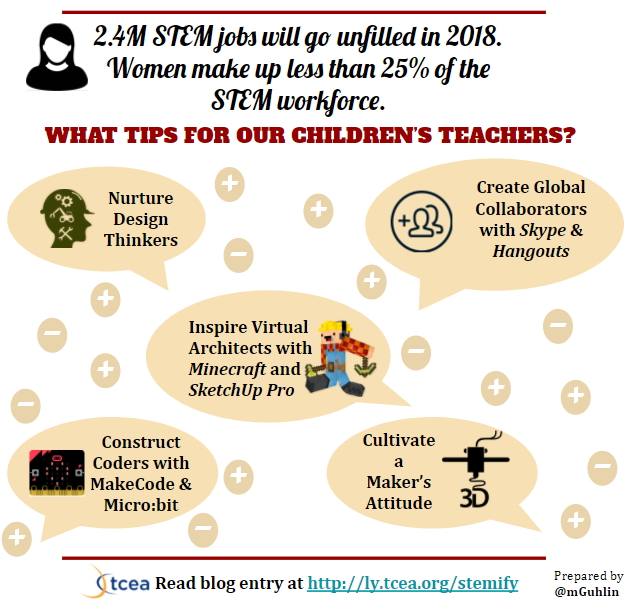At Houston Baptist University’s 10th Annual Teaching and Learning Symposium on Saturday, April 14, 2018, the keynote focused on Making Fire: Kindling STEM Learning in Your Classroom. The presentation focused on introducing STEM teaching and learning strategies that work. Allow me to share with you three of the five tips presented. As you read this blog entry, ask yourself which ones of these have you employed successfully in your classroom?
Why STEM?
Educating students in STEM subjects (if taught correctly) prepares students for life. Those subjects teach students how to think critically, how to solve problems. These skills can be used in life. Source: Adapted from Why STEM?
What’s your child learning in middle school? Does it include Python? I wish I had found a way to introduce my daughter to Python. It would have prepared her for the future. If she had learned Python in middle school, she would have had an easier time in college. Neither of us could predict that she would need it as part of her career in digital mapmaking with ArcGIS. We must encourage all our children to begin with coding.

Tip #1 – Encourage students to engage in solving real-life problems
Problem-Based Learning (PBL) helps students foster team-building and solve real life problems. Ninety-three percent of Generation Z students prefer real life problem solving. A PBL activity presents a real life problem that captures students’ imagination. It engages them emotionally and intellectually. Over time, they learn to see this problem through the eyes of all stakeholders and develop a multi-faceted solution.
STEM Problem Design
Anne Jolly suggests some criteria for selecting STEM problems. Those criteria, quoted below, include:
- Real: The problem must be real. It must involve an authentic engineering challenge grounded in compelling societal, economic, and environmental issues that affect people’s lives and communities.
- Relate-able: Students must be able to relate to the problem. This needs to be a significant challenge students care about.
- Do-Able: The problem should be “doable.” For a STEM project to be successful, students should have access to the resources, knowledge, and skills they need to solve the problem—and the scope of the problem should be manageable.
- Parallel Problem-Solving: The problem must allow for multiple acceptable approaches and solutions…each team of students might choose a different approach for solving the problem, and several different solutions may work.
- Divergent Solutions-Oriented Process: Students should use an engineering design process—drawing on science, mathematics, and technology skills and concepts—to solve the problem.
- Standards Aligned: The problem should align with grade-level standards for science and mathematics.
Examples
Consider these three examples of student robotics projects that caught my eye at the TCEA 2018 State Robotics Competition. Can you identify how each meets the criteria shown above with the information provided in the photo?
Remember, begin with an engaging problem that invites parallel problem-solving. Students will work hard to solve it. They may work even harder if you empower them to develop the problem.
Tip #2 – Promote intercultural learning, real-world opportunities for students
With quick access to various communication technologies, why not provide meaningful, relevant, inter-cultural, real-world opportunities for students?
- Create a school hashtag to build a global presence and organize activities (#stemeachday)
- Create a global conversation around student work
- Enable students to research wonders or problems in their community and post their solutions on YouTube
One successful strategy involves virtual field trips. Curious about how to take your students on virtual field trips? Be sure to review the Skype in the Classroom Getting Started Guide or connect with others using Google Hangouts in Education.
Digital Connections Made Possible
There are many types of connections possible. Explore a few listed below.
- Fight Stereotypes with Mystery Skype
- Second Grade Culture Exchange, an eighth grade class in Minnesota interested in a Mystery Hangout, and a third grade Spanish-speaking class.
- Mystery Hangout: Mystery Hangout is a social game played with two groups of students. It’s a mix of Battleship and 20 questions.
As you might imagine, the possibilities are endless for connecting with educators passionate to unite globally, and what a great opportunity for your students.
Tip #3 – Invite young people to become virtual architects
 In a previous blog entry, I pointed out how Minecraft: Education Edition can be used as a virtual construction space. For the folks at Block by Block, this is a real-life exercise in improving common spaces. The work taps into young women from slums who work as design architects and urban planners. Their workspace is Minecraft’s virtual space.
In a previous blog entry, I pointed out how Minecraft: Education Edition can be used as a virtual construction space. For the folks at Block by Block, this is a real-life exercise in improving common spaces. The work taps into young women from slums who work as design architects and urban planners. Their workspace is Minecraft’s virtual space.
The Block by Block project is the work of UN-Habitat – the United Nations agency for sustainable urban development – together with the makers of the hugely popular world-building computer game Minecraft, Mojang. (Source: Dezeen, 3/7/2017) | Watch the video
Minecraft facilitates communication about re-designing public spaces (see examples). Students go from physical space to virtual to redesigned space. Students are able to work to solve real problems in virtual space. Officials match funding to student-created solutions. Once funded, designs are implemented in physical space. Amazing. Students learn computational thinking as part of their STEM problem solution development.
Ready to Create Fire in Your STEM Classroom?
Get started with do-it-yourself STEM learning in your classroom. Sign up for one of the upcoming learning opportunities at the 2018 TCEA Microsoft Academy or a professional learning opportunity near you.


